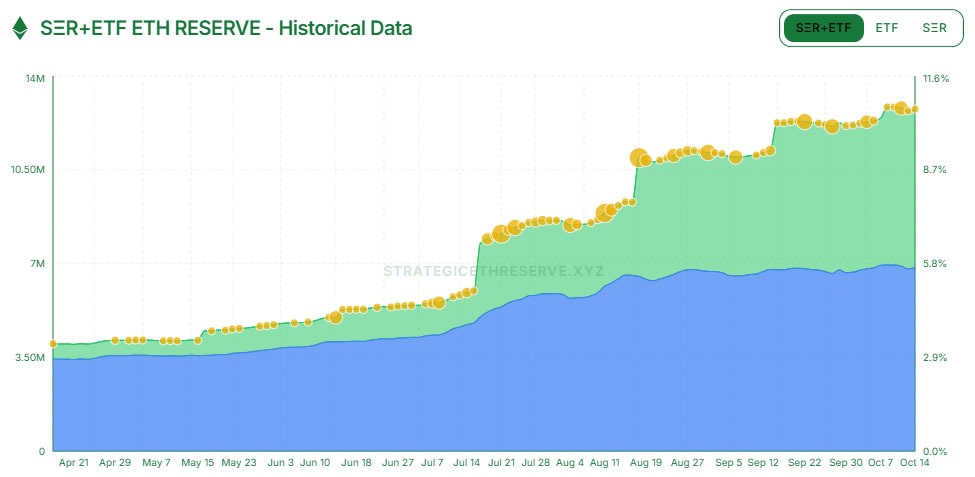The Ether supply squeeze is driven by record institutional accumulation: digital asset treasuries, spot ETFs and staking have removed roughly 40% of ETH from the liquid float, creating strong upward price pressure as demand meets a shrinking available supply.
-
Record institutional hoarding: DATs, ETFs and staking are collectively removing a significant portion of ETH from circulation.
-
Spot ETFs have accumulated millions of ETH while staking and DATs lock up longer-term balances, reducing liquidity.
-
Data points: DATs ~5.9M ETH (~4.9% supply), US spot ETFs ~6.84M ETH (~5.6% supply), staked ETH ~35.7M (~30% supply).
Ether supply squeeze: record ETFs, DATs and staking have removed ~40% of ETH from circulation. COINOTAG explains implications and next steps for investors.
What is driving the Ether supply squeeze?
The Ether supply squeeze describes the current market condition where institutional accumulation, spot exchange-traded funds and large-scale staking are removing a growing share of ETH from the liquid supply. This reduced float, combined with ongoing demand, is producing material upward pressure on price and tighter market liquidity.
How much ETH have institutions and ETFs removed from circulation?
Institutional actors and new fund structures have aggregated meaningful reserves of ETH. Digital asset treasuries (DATs) have amassed approximately 5.9 million ETH (about $24 billion), per StrategicEthReserve data. US-based spot Ether ETFs have taken in roughly 6.84 million ETH (~$28 billion). Combined with ~35.7 million ETH currently staked, these pools convert into a markedly smaller liquid float.
These figures come from public tallies and research platforms including StrategicEthReserve and Ultrasound.Money (plain text mentions only). Stake exits remain constrained: the exit queue is reported at around 40 days, further limiting immediate liquidity.
These entities—DATs, ETF-held balances and staked ETH—are predominantly long-duration holders. DATs typically custody ETH for long-term yields, ETFs have institutional custody mandates, and staked ETH is illiquid until withdrawals clear the queue, so much of this supply is effectively locked for the medium to long term.

DATs and ETFs have been hoovering up ETH at record rates this year. Source: StrategicEthReserve
How do staking and ETFs interact to affect liquidity?
Staking removes ETH from freely tradable supply because validators’ ETH is subject to exit conditions and queues. Spot ETFs accumulate ETH on behalf of investors, often holding assets in custody for extended periods. Together they create overlapping layers of illiquidity—one technical (staking) and one institutional (ETFs/DATs)—which magnify the supply reduction beyond simple on-chain metrics.
Research by Ultrasound.Money indicates the net supply change since the Merge has been marginally inflationary (~0.5%), yet the real-world circulating supply has tightened because of institutional stockpiles and staking. For context, Bitcoin’s supply increased ~4% over the same interval, underscoring how unique Ethereum’s dynamics have become.
Frequently Asked Questions
How will the Ether supply squeeze impact price this cycle?
With a smaller liquid float and stronger institutional demand, price is likely to experience outsized upward moves when buyers step in. Historical comparisons are imperfect, but when demand meets materially reduced liquidity, volatility can accelerate and trends can amplify quickly.
Why are ETFs and staking reducing Ether’s liquid supply?
ETFs accumulate ETH to back investor shares, typically keeping holdings in custody rather than trading them freely. Staking locks ETH in validator contracts with exit mechanics that delay sell-side liquidity. Both mechanisms convert active supply into less-accessible stockpiles.
Key Takeaways
- Institutional accumulation is significant: DATs (~5.9M ETH) and US spot ETFs (~6.84M ETH) together represent a multi-million-ETH withdrawal from the liquid market.
- Staking compounds illiquidity: ~35.7M ETH is staked and functionally illiquid while exit queues and protocol mechanics persist.
- Market implications: Reduced float plus strong demand raises the probability of sustained rallies and higher volatility; investors should monitor institutional flows, staking metrics and exit-queue dynamics.
Conclusion
The Ether supply squeeze is a structural development: DATs, ETFs and staking have combined to shrink ETH’s liquid float in ways not seen in prior cycles. Authoritative trackers such as StrategicEthReserve and Ultrasound.Money report the core metrics that underpin this view. Expert commentary—from analysts and practitioners—supports the conclusion that reduced supply coupled with institutional demand will materially influence price dynamics. Monitor fund flows, staking totals and exit-queue times as primary indicators; COINOTAG will continue to publish updates and analysis as events unfold.
